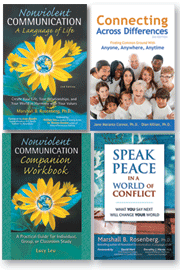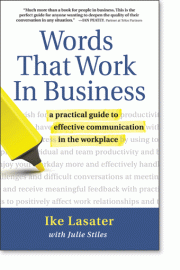Finding Words That Work in Business, continued
We might think about this in three stages: preparing for the conversation, having it, and then learning from it afterward. These three stages may then repeat. If you find that there is an ongoing difficulty in having the kind of connection and relationship you would like to have with a person, you might cycle through these three stages again and again, learning more each time.
The preparing stage involves making sure that you have done your enemy image work ahead of time (see Chapter 5 of Words That Word In Business). If you anticipate that the conversation will be difficult, you might well have judgments and analyses of the person based on past interactions.
Doing the enemy image process -- giving yourself empathy for your judgments and doing silent empathy for the other person -- can help you transform the intense emotional charge you might otherwise have going into the conversation, a charge that will tend to create exactly what you don’t want.
This is particularly true when you have thoughts that you want to make sure you don’t act on. For example, some part of you may believe that the other person is not treating you fairly. If you simply think, “Well, I don’t want to say anything about them not treating me fairly,” you have actually increased the likelihood that your judgment will leak out in some way. In doing the enemy image process, you rehumanize the person and connect with your own needs.
In preparation, you also may want to practice having the conversation with someone else in a role-play. You can tell the other person what you imagine would be difficult for you to hear from the person, and then in the role-play take the time to give yourself empathy, do silent empathy, then formulate a response. In practice this may take a few minutes, but you will still be learning in-the-moment reaction skills by slowing it down -- skills that may well serve you during the actual conversation.
Right before having the conversation, you might want to plan in some time to do self-empathy. Typically, there will be an upwelling of concerns and anxieties before going into a difficult situation; planning a self-empathy session around your reaction to anticipating the conversation, especially with a support person, can help you be present when you go into it. Setting an intention for the conversation ahead of time will also help. You can keep your intention fresh in your mind during the conversation by writing it on a three-by-five card, your hand, or your notepad.
You might well have planned how you want to start, and you may have role-played various versions of the conversation, but in the actual conversation, you want to be as present as possible and not rely on a script that cannot be true to the present moment. Holding your intention foremost in your mind instead of a planned script will help you maintain the kind of spontaneity and flow that the other person is likely to expect from you.
If you are able to do self-empathy during the conversation, it can help by keeping you present to your needs; however, when first learning, it may be more than enough challenge to simply be in the conversation with as much presence as you can muster.
I have found it is best to anticipate that after the conversation, there’s going to be a flood of judgmental thoughts about yourself, the other person, and the situation -- try to schedule a time to do empathy.
During this time, you can celebrate and mourn the needs met and not met in thinking about what happened during the conversation, and you can guess the needs of the other person. You can then shift into figuring out and naming what you learned. In this learning, you might replay how the conversation went, either in your head or again in a role-play with someone else -- but replay it as you would like it to have happened. In this way, you are creating neural networks that store the information in the brain in a way that makes it more readily available when you are next in a similar situation.
After going through this process, you then think about the next step, if there is one. As you plan for that step, if it includes another conversation, you cycle back to the first stage of preparation.
This article was excerpted from Words That Word In Business, scheduled for publication by PuddleDancer Press April 5. Pre-order this new book March 5-April 4, 2010 and save 40% off list price.
Ike Lasater, J.D., MCP, is the author of Words That Work In Business (PuddleDancer Press, Spring 2010), and a former attorney and cofounder of Words That Work, a consulting and training firm helping organizations achieve results through better communication and collaboration. He has worked with individuals and organizations in the US, Australia, Hungary, New Zealand, Pakistan, Poland and Sri Lanka. He is a former board member for the Center for Nonviolent Communication, and the Association for Dispute Resolution of Northern California, and the co-founder of the Yoga Journal magazine.
Keep learning these vital communication skills with these books and training resources:
- NVC Starter Kit Book Package - Save 40% on this package every day from PuddleDancer Press
- Speak Peace in a World of Conflict - Save 30% on this book every day from PuddleDancer Press
- Nonviolent Communication: A Language of Life - Save 30% on this book every day from PuddleDancer Press
- NVC Companion Workbook - Save 30% on this book every day from PuddleDancer Press





